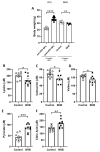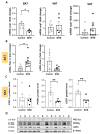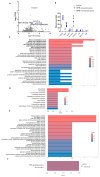β-Hydroxybutyrate Reduces Body Weight by Modulating Fatty Acid Oxidation and Beiging in the Subcutaneous Adipose Tissue of DIO Mice
- PMID: 40507875
- PMCID: PMC12154550
- DOI: 10.3390/ijms26115064
β-Hydroxybutyrate Reduces Body Weight by Modulating Fatty Acid Oxidation and Beiging in the Subcutaneous Adipose Tissue of DIO Mice
Abstract
β-hydroxybutyrate (BHB) serves as an alternative cellular fuel during states of low glucose availability, such as fasting or carbohydrate restriction, when the body shifts to using fats and ketone bodies for energy. While BHB has shown potential metabolic benefits, its mechanisms of action in the context of obesity are not fully understood. In this study, we examined the effects of BHB supplementation on subcutaneous adipose tissue (SAT) metabolism in a diet-induced obesity (DIO) mouse model. Adult male mice were first fed a high-fat diet for six weeks, followed by a standard diet with or without BHB supplementation for an additional six weeks. BHB supplementation led to significant body weight loss independent of food intake. This weight reduction was associated with decreased adipocyte differentiation, reflected by reduced peroxisome proliferator-activated receptor gamma (PPARγ) protein levels and lower uncoupling protein 1 (UCP1) expression, indicating altered SAT function. Transcriptomic analysis of SAT revealed upregulation of genes involved in fatty acid activation and transport (e.g., Slc27a2, Plin5, Acot4, Acsm3, Rik). Functional enrichment highlighted the activation of the PPAR signaling pathway and enrichment of peroxisomal components in the BHB group. Together, these results suggest that BHB promotes lipid remodeling in SAT, enhancing fatty acid metabolism while suppressing thermogenic pathways, and thus may represent a novel mechanism contributing to adiposity reduction and metabolic improvement.
Keywords: SAT; adipose tissue; fatty acid oxidation; obesity; thermogenesis; weight loss; β-hydroxybutyrate.
Conflict of interest statement
The authors declare no competing interests.
Figures




Similar articles
-
Effects of Diets Differing in Composition of 18-C Fatty Acids on Adipose Tissue Thermogenic Gene Expression in Mice Fed High-Fat Diets.Nutrients. 2018 Feb 23;10(2):256. doi: 10.3390/nu10020256. Nutrients. 2018. PMID: 29473916 Free PMC article.
-
Antiobesity efficacy of GLP-1 receptor agonist liraglutide is associated with peripheral tissue-specific modulation of lipid metabolic regulators.Biofactors. 2016 Nov 12;42(6):600-611. doi: 10.1002/biof.1295. Epub 2016 May 23. Biofactors. 2016. PMID: 27213962
-
Attenuation of brown adipocyte whitening in high-fat diet-induced obese rats: Effects of melatonin and β-hydroxybutyrate on Cidea, Fsp27 and MT1 expression.Diabetes Obes Metab. 2024 Oct;26(10):4551-4561. doi: 10.1111/dom.15810. Epub 2024 Aug 8. Diabetes Obes Metab. 2024. PMID: 39118207
-
Cinnamaldehyde Ameliorates Diet-Induced Obesity in Mice by Inducing Browning of White Adipose Tissue.Cell Physiol Biochem. 2017;42(4):1514-1525. doi: 10.1159/000479268. Epub 2017 Jul 18. Cell Physiol Biochem. 2017. PMID: 28719892
-
Resveratrol derivative BTM-0512 mitigates obesity by promoting beige remodeling of subcutaneous preadipocytes.Acta Biochim Biophys Sin (Shanghai). 2017 Apr 1;49(4):318-327. doi: 10.1093/abbs/gmx009. Acta Biochim Biophys Sin (Shanghai). 2017. PMID: 28338809
References
MeSH terms
Substances
Grants and funding
LinkOut - more resources
Full Text Sources
Medical
Research Materials

